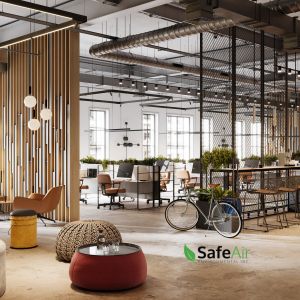How Workplace Air Quality Affects Your Health
Posted in Air Quality, on September 20, 2023
If a long day at the office has you feeling congested, stuffed up, or itchy-eyed, it may not be the flu making the rounds — it could be the air quality. At SafeAir, we regularly perform air quality testing in Toronto area businesses and offices alongside our regular home air quality services. Many health and safety committees, managers, and CEOs are learning about the unknown dangers lurking at work that reduce efficiency, increase absenteeism, and cause long-term illness. Whether you’d like a specific service like radon testing or a generalized environmental assessment, SafeAir can help you at home or work!
Four Common Workplace Contaminants
SafeAir’s work and home air quality assessments often find the following contaminants in the environment.
Radon Gas
 Radon is an odourless and colourless gas that occurs naturally. In small quantities, radon gas is relatively harmless, but when it builds up in an environment, it causes respiratory illness and lung cancer. Cracks and gaps in the building envelopes of lower level and basement units often attract radon through negative pressure, and harmful quantities may build up. Radon testing is the only way to detect the presence of this gas in your building.
Radon is an odourless and colourless gas that occurs naturally. In small quantities, radon gas is relatively harmless, but when it builds up in an environment, it causes respiratory illness and lung cancer. Cracks and gaps in the building envelopes of lower level and basement units often attract radon through negative pressure, and harmful quantities may build up. Radon testing is the only way to detect the presence of this gas in your building.
Mold
Common in residential and commercial spaces, mold is a damaging fungal infestation that can cause thousands of dollars worth of structural damage and severe consequences to human health. Mold has a musty odour that is easy to identify, and it can damage and cause visible marks or staining to structures, merchandise, and office equipment. Mold exposure commonly causes flu-like symptoms, making it difficult to diagnose. The clue that it’s mold, not the flu, is that symptoms clear up when you leave the building.
Carbon Dioxide
CO2 can build up in spaces where there is inadequate airflow and venting. Fossil fuels are the number one source of CO2 in indoor environments; furnaces, heaters, woodstoves, equipment, and even idling cars near air intake vents can all increase workplace CO2 exposure. Common symptoms include feeling ill, nauseous, lethargic, having shortness of breath or headaches.
Dust and Asbestos
Many of the older buildings in Toronto were built before asbestos bans came into effect, and may contain products or insulation made with asbestos. Untouched, asbestos is harmless, but when dust, chips, or small particles of asbestos are created or disturbed, it becomes a hazard to human health. SafeAir recommends asbestos testing before significant renovations or repairs to ensure none of the affected areas contain asbestos.
How to Protect Your Property
First and foremost, owners and managers must monitor and evaluate workplace health and safety, but every team member can and should have a say. SafeAir has been helping small and large businesses with air quality testing in Toronto for over a decade. Our reliable, discreet, and science-based services evaluate and test indoor air quality for various contaminants that can harm you, your colleagues, clients, and guests.
To learn more about how air quality testing, radon testing, or a specific service can help you, reach out to SafeAir online or by phone to learn more.

